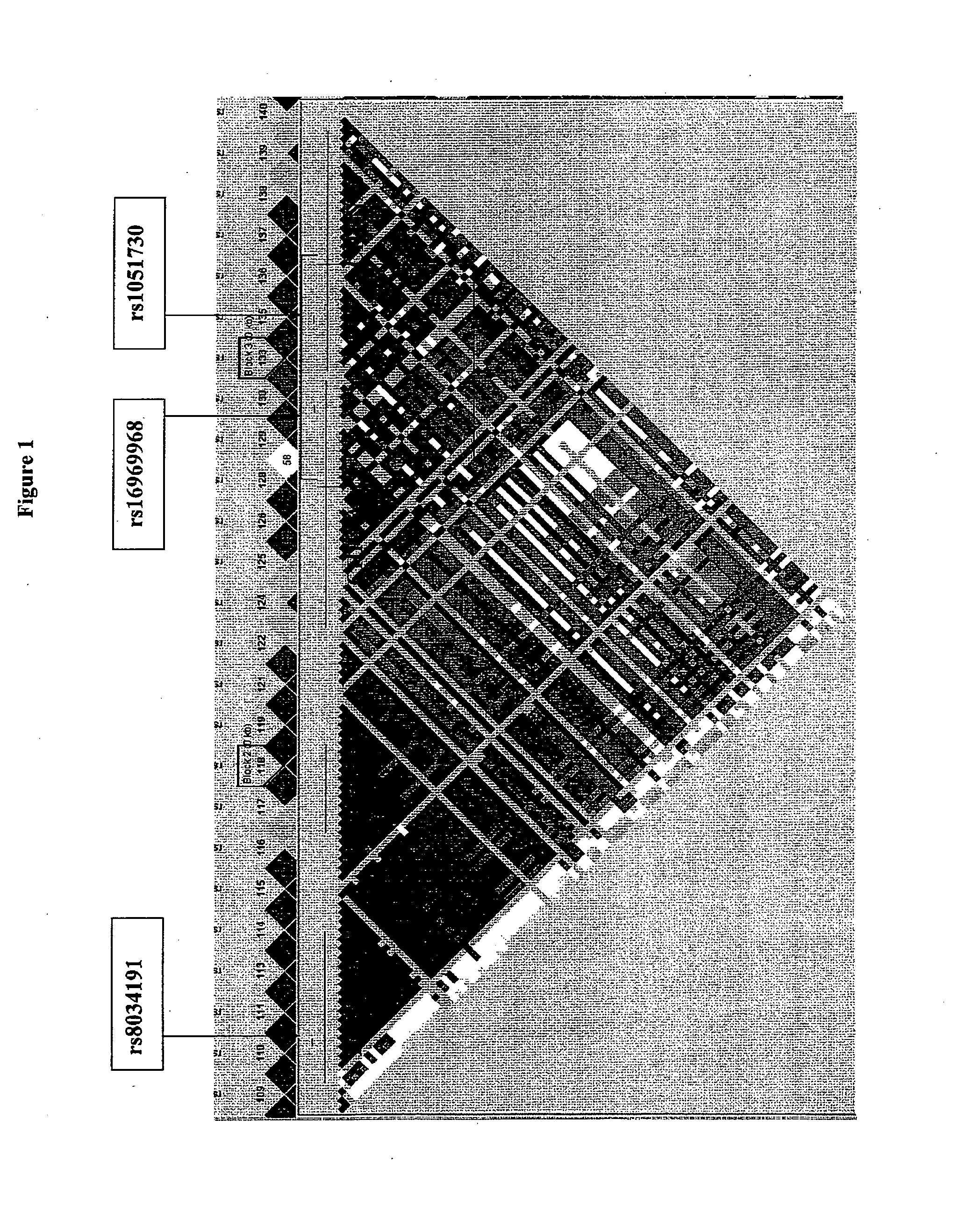Methods and compositions for assessment of pulmonary function and disorders
a pulmonary function and pulmonary disease technology, applied in the field of methods for assessing pulmonary function and/or disorders, can solve the problems of significant loss and the inability to avoid the symptoms of worsening breathlessness
- Summary
- Abstract
- Description
- Claims
- Application Information
AI Technical Summary
Benefits of technology
Problems solved by technology
Method used
Image
Examples
example 1
Case Association Study
Introduction
[0630]Case-control association studies allow the careful selection of a control group where matching for important risk factors is critical. In this study, smokers diagnosed with lung cancer and smokers without lung cancer with normal lung function were compared. This unique control group is highly relevant as it is impossible to pre-select smokers with zero risk of lung cancer—i.e., those who although smokers will never develop lung cancer. Smokers with a high pack year history and normal lung function were used as a “low risk” group of smokers, as the Applicants believe it is not possible with current knowledge to identify a lower risk group of smokers. The
[0631]Applicants believe, without wishing to be bound by any theory, that this approach allows for a more rigorous comparison of low penetrant, high frequency polymorphisms that may confer an increased risk of developing lung cancer. The Applicants also believe, again without wishing to be bound...
example 2
4 SNP Panel
[0677]Genotype type data for many SNPs can be combined according to an algorithm where the presence of a susceptibility genotype is assigned a positive score, while the presence of a protective genotype is assigned a negative score. This allows genotype data for a panel of SNPs to be combined to generate a score indicating a level of susceptibility to lung cancer. This score is referred to herein as the lung cancer susceptibility (LCS) score.
[0678]This example presents an analysis of distributions of LCS scores derived for lung cancer sufferors and control resistant smokers using a 4 SNP panel as described below.
[0679]LCS scores for each subject were derived by assigning a score of +1 for the presence of each susceptiblility genotype, or 1 for the presence of each protective genotype in the 4 SNP panel. The 4 SNP panel comprised the nAChR rs16969968 G / A polymorphism, the HHIP rs1489759 A / G polymorphism, and the GYPA rs2202507 A / C polymorphism, the Solute Carrier Family 34...
example 3
5 SNP Panel
[0681]This example presents an analysis of distributions of LCS scores derived for lung cancer sufferors and control resistant smokers using a 5 SNP panel as described below.
[0682]LCS scores for each subject were derived by assigning a score of +1 for the presence of each susceptiblility genotype, or −1 for the presence of each protective genotype in the 5 SNP panel. The 5 SNP panel comprised the nAChR rs16969968 G / A polymorphism, the HHIP rs1489759 A / G polymorphism, the GYPA rs2202507 A / C polymorphism, the Solute Carrier Family 34 (SLC34A2) rs 2240997, and the HLA-B associated transcript 3 (BATS) rs 1052486 A / G polymorphisms. The scores were added to derive the 5 SNP panel LCS score for each subject. Table 14 below shows the distribution of LCS scores derived from the 5 SNP panel amongst the lung cancer patients and the resistant smoker controls.
TABLE 14Lung cancer susceptibility score from the 5 SNP panelLow risk scoreNeutralHigh risk scoresScore−2−101 or 2 or 3Controls...
PUM
| Property | Measurement | Unit |
|---|---|---|
| concentration | aaaaa | aaaaa |
| concentration | aaaaa | aaaaa |
| resistance | aaaaa | aaaaa |
Abstract
Description
Claims
Application Information
 Login to View More
Login to View More - R&D
- Intellectual Property
- Life Sciences
- Materials
- Tech Scout
- Unparalleled Data Quality
- Higher Quality Content
- 60% Fewer Hallucinations
Browse by: Latest US Patents, China's latest patents, Technical Efficacy Thesaurus, Application Domain, Technology Topic, Popular Technical Reports.
© 2025 PatSnap. All rights reserved.Legal|Privacy policy|Modern Slavery Act Transparency Statement|Sitemap|About US| Contact US: help@patsnap.com


